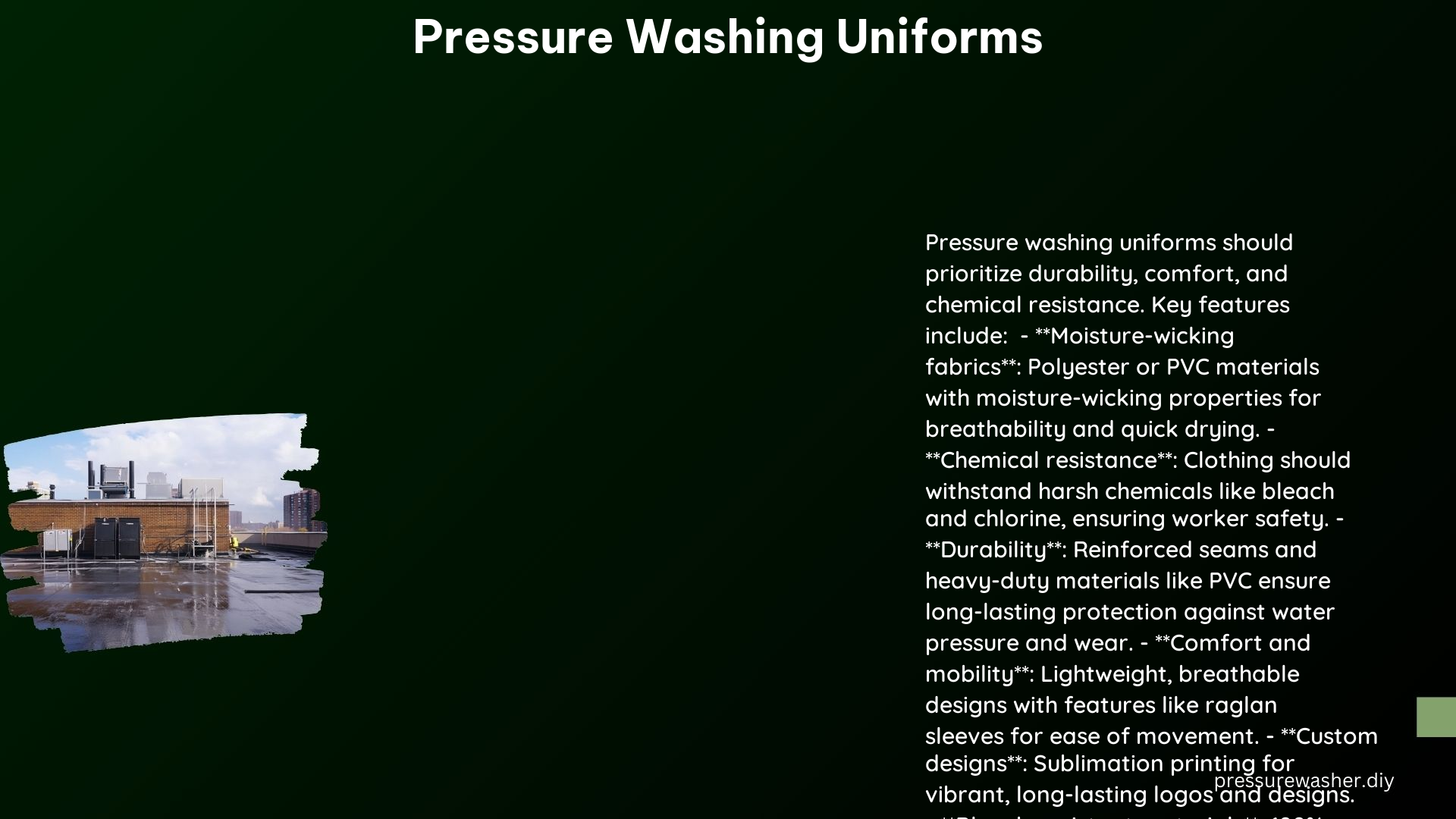Pressure washing is a demanding job that requires specialized equipment and protective gear to ensure the safety and comfort of the workers. Pressure washing uniforms are essential for professionals in the industry as they provide protection, comfort, and a professional appearance. This comprehensive guide will delve into the key components, technical specifications, best practices, and recommended suppliers for pressure washing uniforms.
Key Components of a Pressure Washing Uniform
Shirts
- Material: 100% polyester or high-quality fabrics with moisture-wicking properties are ideal for pressure washing shirts. These materials ensure durability, comfort, and quick drying. Polyester fabrics typically have a weight range of 4-6 oz/yd² and a tensile strength of 50-80 lbs/in, providing the necessary strength and breathability for pressure washing tasks.
- Design: Custom designs with logos, graphics, and contact details can enhance the professional appearance of the uniform. Sublimation printing is a popular method for creating durable, vibrant, and fade-resistant designs that can withstand the harsh conditions of pressure washing.
Pants and Shorts
- Material: Similar to shirts, 100% polyester or high-quality fabrics with moisture-wicking properties are recommended for pants and shorts. These materials provide comfort, durability, and resistance to bleach and other chemicals. Polyester pants and shorts typically have a weight range of 5-8 oz/yd² and a tensile strength of 60-90 lbs/in.
- Design: Custom designs can be applied to pants and shorts to maintain a consistent professional look. Embroidered logos and graphics are a popular choice for adding a touch of personalization to the uniform.
Jackets
- Material: PVC or PVC-containing materials are highly recommended for jackets due to their strength, suppleness, waterproofing, and durability. PVC jackets typically have a thickness of 0.5-0.8 mm and a tensile strength of 12-18 MPa, making them highly resistant to the rigors of pressure washing.
- Design: Jackets can be designed with custom logos and graphics to match the overall uniform. Sublimation printing or heat-sealed vinyl appliqués are effective methods for creating durable and visually appealing designs.
Hats
- Material: Hats can be made from a variety of materials, including polyester, cotton, or blends. Bleach-resistant materials are preferred to ensure the hats maintain their appearance and functionality even after repeated exposure to harsh chemicals. Polyester hats typically have a weight range of 3-5 oz/yd² and a UPF (Ultraviolet Protection Factor) of 30-50+, providing effective sun protection for pressure washing workers.
- Design: Custom designs and logos can be applied to hats to complete the uniform. Embroidery and screen printing are common techniques for adding personalized branding to hats.
Technical Specifications

Fabric Properties
- Moisture-wicking: Fabrics should be able to quickly absorb and evaporate moisture to keep workers comfortable and dry. Polyester and other synthetic fabrics typically have a moisture-wicking rate of 70-90%, ensuring efficient moisture management.
- Bleach Resistance: Fabrics should be able to withstand exposure to bleach and other harsh chemicals without deteriorating. Polyester and PVC-based materials have excellent resistance to bleach, with a bleach resistance rating of 4-5 on a scale of 1-5.
- Durability: Fabrics should be able to withstand the physical demands of pressure washing, including high water pressure and frequent use. Polyester fabrics have a Martindale abrasion resistance of 20,000-30,000 cycles, ensuring long-lasting performance.
Design and Printing
- Sublimation Printing: This method ensures that designs and logos are durable and resistant to fading or cracking. Sublimation printing can achieve a print resolution of up to 1440 dpi, providing high-quality, vibrant, and long-lasting graphics.
- Embroidery: Embroidered designs can provide a professional, long-lasting appearance. Embroidery stitches typically range from 6-12 stitches per inch, ensuring a clean and detailed finish.
Best Practices for Pressure Washing Uniforms
- Comfort and Mobility: Uniforms should prioritize comfort and mobility to ensure workers can perform their tasks efficiently. Fabrics with a stretch factor of 10-20% can provide the necessary flexibility and range of motion for pressure washing tasks.
- Durability and Waterproofing: Uniforms should be designed to withstand the harsh conditions of pressure washing, including high water pressure and exposure to chemicals. PVC-based materials and water-repellent finishes can provide effective waterproofing and chemical resistance.
- Professional Appearance: Uniforms should be designed to project a professional image, enhancing the reputation of the pressure washing business. Consistent branding, high-quality materials, and a well-coordinated design can contribute to a polished and professional appearance.
Recommended Suppliers
- Queensboro: Offers a range of pressure washing uniforms, including shirts, jackets, and hats, with custom embroidery options. Their polyester shirts have a weight of 5.5 oz/yd² and a tensile strength of 75 lbs/in, while their PVC jackets have a thickness of 0.6 mm and a tensile strength of 15 MPa.
- Fin-Print: Provides high-quality, bleach-resistant uniforms with custom designs and durable printing. Their polyester fabrics have a weight of 6 oz/yd² and a Martindale abrasion resistance of 25,000 cycles.
- Tampa Clothing: Specializes in custom pressure washing shirts with moisture-wicking properties, durable printing, and comfortable designs. Their polyester shirts have a weight of 5.8 oz/yd² and a moisture-wicking rate of 80%.
- Stormline: Offers PVC-based waterproof gear designed specifically for pressure washing, prioritizing durability and comfort. Their PVC jackets have a thickness of 0.7 mm and a tensile strength of 16 MPa.
- DesignsAnHour: Provides custom pressure washing shirts with sublimation printing and embroidery options. Their polyester shirts have a weight of 5.2 oz/yd² and a print resolution of 1440 dpi for high-quality graphics.
By considering the key components, technical specifications, and best practices outlined in this guide, pressure washing professionals can select the most suitable and effective uniforms to protect their workers, maintain a professional appearance, and enhance the overall efficiency of their operations.
